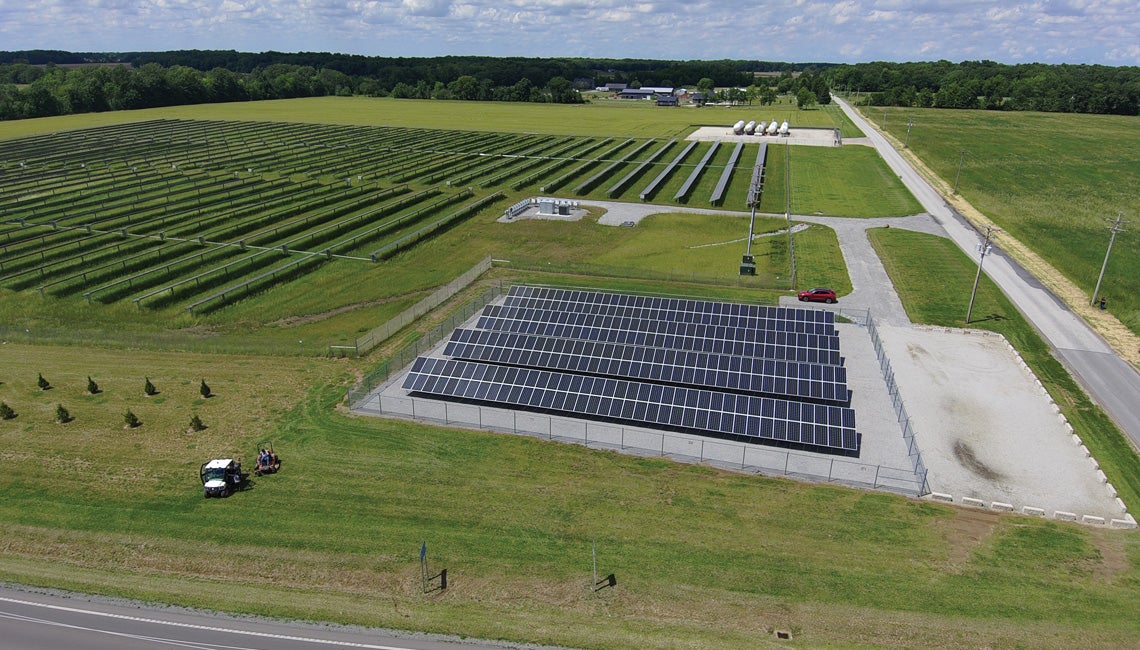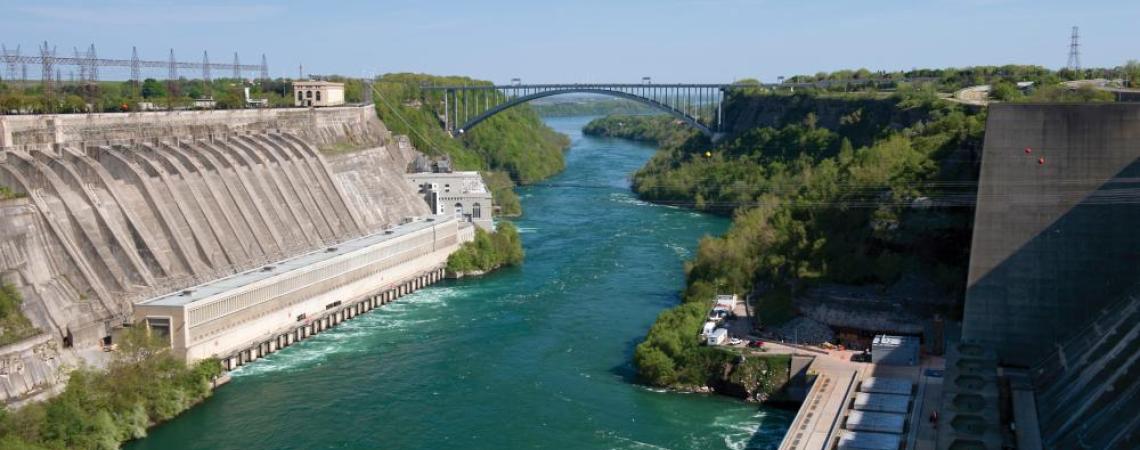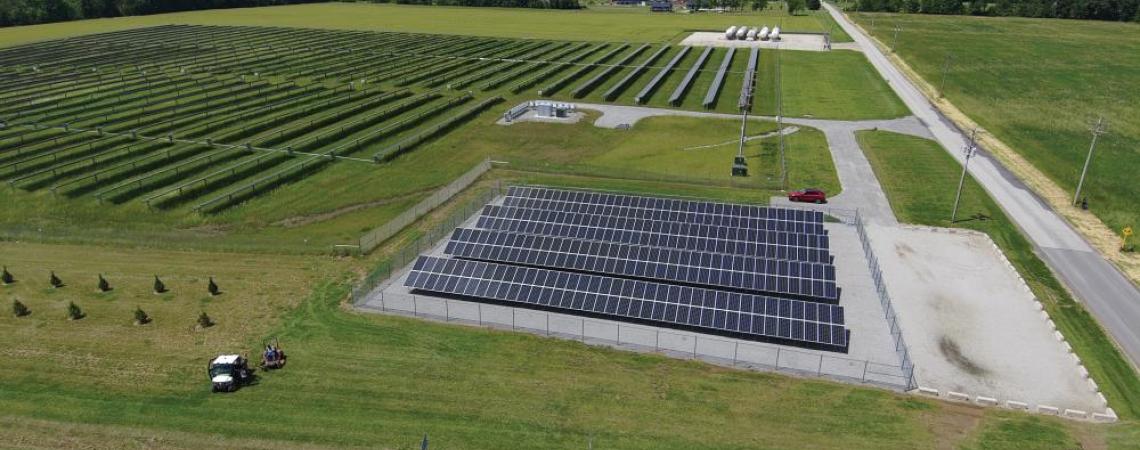There’s an important debate going on currently about the best way to generate electricity to power America’s homes and businesses, framed something like this: Low- or zero-carbon-emission sources that are both generally expensive and only intermittently available on the one side; reliable and economical but carbon-emitting sources on the other.
Ohio’s electric cooperatives, however, insist that generation shouldn’t be a matter of either/or — either fossil-fuel generation or renewable energy sources. Instead, they execute an all-of-the-above strategy, utilizing the best available mix while also planning for the future with growing use of renewable sources like solar energy — when it’s logical to do so.
The New York Power Authority’s Niagara Power Project and St. Lawrence-FDR Power Project send 55 megawatts of hydroelectric power to Ohio’s electric cooperative members.
“While coal and natural gas provide the bulk of our electricity supply in a reliable and cost-competitive manner, we continue to seek opportunities to develop renewable energy projects that make sense for our members,” says Pat O’Loughlin, president and CEO of Ohio’s Electric Cooperatives, the trade association that provides services to the 24 electric distribution cooperatives in the state. “Our hydropower, bio-gas, and solar resources are an important part of the mix. We’re always looking to grow and expand our supply resources in economical, practical, and beneficial ways.”
With that in mind, Ohio’s cooperatives actively oppose new federal regulations that could force the closure of coal-fired power plants in the U.S., because those plants are critical to meeting the needs of cooperative members. That doesn’t mean co-ops are fighting against renewable energy, but instead are advocating for a realistic timeline for reducing use of fossil fuels. In fact, Ohio’s electric cooperatives and Buckeye Power, the generation and transmission cooperative providing electricity to the state’s co-ops, have expanded renewable energy offerings in ways that meet co-op members’ needs and frequently analyze options to grow renewable generation.
That focus on members’ interests has driven Buckeye Power’s current energy mix, and will continue to guide growth in the future, says Craig Grooms, chief operating officer. “Our mission is to provide affordable, reliable, and environmentally responsible power,” he says. “Affordability and reliability drive everything we do.”
Buckeye’s current portfolio is reliable and cost-effective, so potential changes must be evaluated carefully. “We have sufficient generation capacity, and it’s still affordable,” says Ben Wilson, assistant vice president of power delivery for Buckeye Power. “It’s like we have a very reliable car that’s not a brand-new car but still runs great. We’ll take action if and when members tell us they want us to and we can do it economically.”
Government grants could make new green-energy projects more feasible. “We’re exploring federal funding opportunities that might make sense for Ohio co-op members,” Grooms says. “We’re looking at solar, batteries, or maybe a combination of those.”
In the following paragraphs, we take an honest look at the current status, as well as future growth potential, of various renewable sources of generation.
“Every form of energy has trade-offs,” Grooms says. “There is no perfect form of energy. It’s easy to say we should just build enough solar and wind and transport it where it’s needed, but designing something in a model isn’t the same as building it in reality. It took it more than 100 years to get where we are. We can’t expect that in 15 years, we’re going to transition to something completely different.”
Hydroelectric power – A reliable renewable
STATUS: About 75% of Buckeye Power’s renewable energy comes from hydropower, though Ohio lacks the geography — specifically, significant elevation changes — needed to produce large amounts of electricity from dammed rivers in the state. Instead, Buckeye has an agreement with the New York Power Authority to purchase 55 megawatts of hydropower from the Niagara and St. Lawrence-FDR power projects.
ANALYSIS: Hydroelectric power, which relies on the ongoing movement of water through turbines, is a proven and reliable renewable, providing consistent baseload generation as the rivers flow.
However, environmental concerns are now driving efforts to reduce hydropower facilities, particularly in the western U.S. “If anything, there is a push to retire these plants, rather than building new ones,” Buckeye’s Ben Wilson says.
OUTLOOK: While hydropower will continue to be an important portion of renewable energy in the U.S. and in Ohio’s energy mix, it’s not a likely source of growth to replace fossil fuels or meet ever-growing energy demands. Hydroelectric power blossomed in the U.S. starting in the late 1800s, and most rivers that are suitable for hydroelectric plants already have them.
Wind energy – The price is wrong
STATUS: Wind, which is an intermittent source like solar, isn’t a significant portion of Buckeye Power’s generation mix. The small amount of wind power it receives comes from member-owned facilities that produce excess energy that feeds back into the grid.
ANALYSIS: “Wind can fit into an overall portfolio,” Ben Wilson says. “It’s lost favor to solar because solar prices have come down quite a bit, while wind costs have not.” Solar generation also edges out wind for Ohio because solar arrays produce well during the hottest peak-demand weeks of summer. “Sometimes, there’s no wind on hot days, when the energy is really needed.”
OUTLOOK: Buckeye Power experimented with wind power partnerships for a project in Iowa several years ago, says OEC’s Craig Grooms, but eventually, transmitting that power from the area of the country with the best wind production (the Great Plains) to Ohio simply was not cost-effective. “What we learned, primarily, is there is a lot of value in having our power generation close to where we actually consume it,” Grooms says.
As the market changes, wind might become more viable for Ohio’s co-ops, Wilson says. “If wind prices come down, we could shift back that way.”
Community solar – By co-ops for co-op members
STATUS: Solar power currently provides a little more than 5% of the power from renewable sources in Buckeye Power’s energy mix. Ohio cooperatives have invested in community solar through the OurSolar project, rather than building industrial-scale solar arrays, says Ryan Goolsby, director of engineering at Hancock-Wood Electric Cooperative in New Baltimore.
“OurSolar was sized based on the interest of members,” Goolsby says. “Ohio has seen opposition to very large projects converting thousands of acres of farmland to solar panels to sell electricity into the market. This is a much smaller scale; it’s by co-ops for co-op members.”
OurSolar’s first phase in 2017 saw smaller arrays go up at 23 co-op sites around Ohio. The second phase — a single 14-acre site on Hancock-Wood property with allocations to all Ohio co-ops — doubled the generation capacity for Ohio’s cooperatives, to 4.1 megawatts.
ANALYSIS: Solar energy offers some advantages. First, of course, is the environmental benefit of carbon-free generation from the sun. In addition, the technology for solar panels is readily available and the costs have been coming down, making solar energy less cost-prohibitive than in years past.
Anyone who’s spent a winter in Ohio, however, can attest to one of solar energy’s major shortcomings: The sun doesn’t always shine. So, while OurSolar has the capacity to produce 4.1 MW, “that’s at midday on a nice, sunny day across Ohio,” says OEC’s Ben Wilson. On average, actual generation from the solar panels is closer to 1 MW because of cloudy days and dark nights, when little to no electricity is produced.
With community solar, members benefit because they can access solar energy without the up-front costs of rooftop panels. “Most members don’t have the roughly $18,000 or more needed for an average home solar installation,” Goolsby says. “Additionally, residential solar typically excludes renters, homeowners in certain HOAs, and homeowners whose property isn’t well-suited for solar production. OurSolar is there for any member.”
OUTLOOK: Because solar production is intermittent, though, it makes sense only when complementing reliable, always-available generation. The outlook is better when solar generation is paired with battery storage, to provide electricity when the sun isn’t shining.
“Battery storage is still new enough that there are concerns about longevity and performance,” Wilson says. “But the signs are good that battery storage will be part of grid operations going forward. Pairing solar with batteries is still pricy, but the technology works and can be part of a diverse resource mix.”
Biogas – Turning waste into energy
STATUS: Nearly 20% of Buckeye Power’s renewable energy comes from member-owned facilities that produce electricity from methane gas — and two-thirds of that comes from landfills, which produce methane as organic garbage decomposes. The rest comes from anaerobic digesters, which break down animal waste for methane, at co-op member-owned farms.
OUTLOOK: While these are valuable sources of renewable energy, significant growth in this area isn’t expected.
Deep geothermal – Maybe someday
STATUS: An endless supply of energy exists in Earth’s super-hot core, and keeps the ground even a few feet down at nearly constant temperatures year-round. Homeowners and businesses already can tap into that resource for heating and air conditioning through geothermal heat pumps. Similarly, larger-scale facilities can generate electricity in places where geothermal energy is close to the surface (think volcanoes and geysers).
OUTLOOK: Ohio is not one of those places. Advances in drilling technology could make deep geothermal an option in the future, even where the Earth’s heat is more deeply buried. “Techniques for (natural gas) fracking have gotten very good for deep drilling,” OEC’s Ben Wilson says. “The idea is to drill wells so deep that we can capture that heat. That could happen here in the future.”
Nuclear power – High risk, high reward
STATUS: Nuclear power combines the benefits of zero carbon emissions seen in wind and solar production with high reliability that is industry-leading. “Nuclear is the best of both worlds,” says OEC’s Ben Wilson. “It has no emissions, but it’s very reliable, always on, providing very good baseload power.”
ANALYSIS: With those benefits, why doesn’t Ohio just build nuclear plants to replace coal generation and meet growing energy demand? The answer hinges on cost, time, and red tape. In the past year, utilities in Georgia opened two new nuclear reactors, the first such units built in the U.S. in decades. They will provide carbon-emission-free electricity for years to come, but the project came in about $17 billion and seven years over initial projections. Government regulatory hurdles, coupled with the time and money needed to site, plan, and build new nuclear facilities, make this attractive energy source a very long-term and risky investment.
OUTLOOK: There is hope on the horizon for more practical deployment of nuclear energy in the form of small modular reactors, also called SMRs. These advanced reactors, which are still in the research and development phase, are smaller than conventional reactors and will provide several advantages, including having a smaller footprint (making them feasible on sites not large enough for conventional facilities) and consisting of prefabricated units that can be manufactured elsewhere and then installed on-site. Once this technology is available — though no one can say when that will be — new nuclear generation could become more practical.
What’s a megawatt?
Power generation is often measured in megawatts (MW). One megawatt is equal to 1 million watts (or 1,000 kilowatts). Each MW of electricity can power about 250 homes during the hottest or coldest hours of the year.











